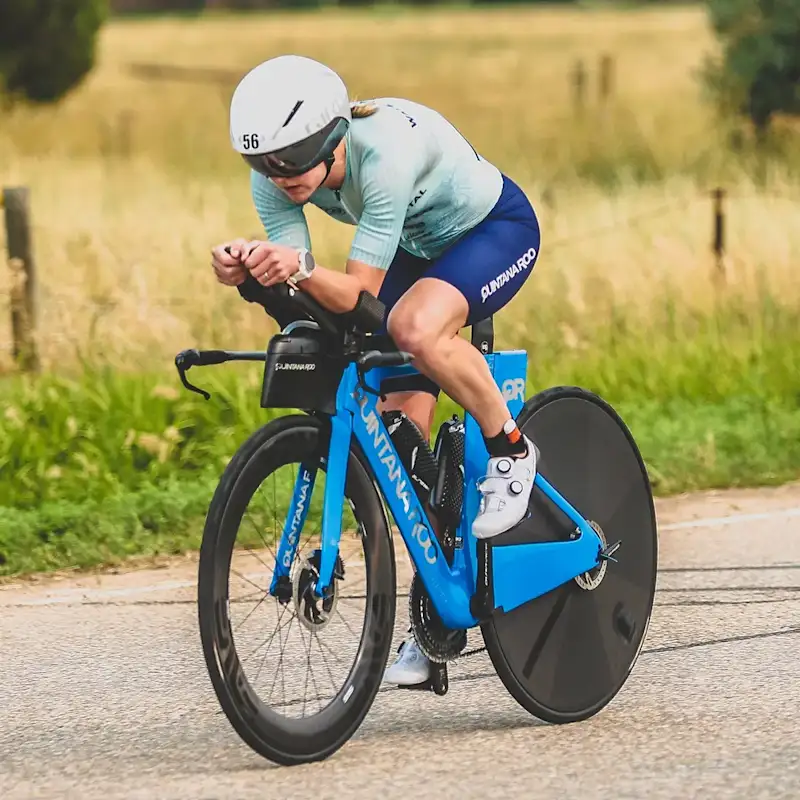
Jeanni Metzler
IRONMAN 70.3® Oceanside
Jeanni's headline numbers
Jeanni's strategy
Fueling
Carbohydrate is the main fuel you burn when racing. Failing to fuel properly is a leading cause of underperformance in longer races.
Jeanni averaged ~56g of carbohydrates per hour, her lowest fuel intake of the season, mostly using PF Carb & Electrolyte Drink Mix, PF 30 Gels, and PF 30 Chews. Unfortunately, she struggled with GI issues during the race, possibly from the stomach bug she’d picked up the day prior, which prevented her from finishing her drinks and limited her intake of gels. Therefore, her intake fell significantly below the recommended range of 90g/h for optimal performance in a race of this length and intensity. Jeanni did manage to front-load her intake, achieving over 60g/h on the bike; however, her consumption dropped to just ~23g/h on the run. This tapering in carbohydrate consumption is not uncommon and can be an effective fueling strategy in triathlons, but Jeanni took this too far with such a low run intake. We hope to see her aim for the higher end of the recommended range on the bike, with a more balanced approach to her run intake when she is in better health.
Hydration
Taking on board an appropriate amount of fluid and sodium is essential to maintaining blood volume and supporting the cardiovascular effort needed to perform on race day.
Whilst the absolute amount of sodium and fluid consumed per hour is important, it’s critical to consider these in relation to each other. This is known as 'relative sodium concentration' and it’s expressed in milligrams per litre (mg/L). How much sodium you’re taking in per litre of fluid is more important than the absolute amount taken in per hour.
Sweat sodium concentration (mg/L) is largely genetically determined and remains relatively stable. Knowing how salty your sweat is enables you to replace a good proportion of your sweat losses, which can range from 200-2,000mg/L.
Given Jeanni’s losses are Very High (1,556mg/L), nailing her hydration strategy remains important, even when it’s Mild.
Learn moreGiven the mild conditions, Jeanni’s fluid intake seems adequate, but with a closer look, it’s actually on the lower side for her individual losses, especially compared to her intake during previous races like The Collins Cup, and the 70.3® World Championships this year. Her fluid consumption at this race was certainly hindered by her stomach comfort and although she peed once at the start of the run, indicating she was not severely dehydrated, she rated her hydration at a 6 out of 10, noting she could have consumed more, especially water, during the run. Jeanni took on a relative sodium concentration which effectively replaced a significant portion of her sweat sodium losses, given her high sweat sodium concentration, and did not experience cramps. Since she felt the extra PH 1000 on the bike was unnecessary in the overcast conditions, she may have been craving a bit more fluid to replenish her losses more in line with the amount she typically drinks.
Caffeine
Beyond the Three Levers of Performance (carb, sodium and fluid), caffeine is one of only a few substances that is proven to improve performance for most endurance athletes as it can help stave off mental and physical fatigue.
Jeanni started her day with a coffee and consumed a small dose of caffeine during the race through caffeinated energy chews and Cola. The caffeine would have helped elevate her perceived energy levels, particularly beneficial since she wasn't feeling her best. During the race, she ingested ~1.87mg/kg of caffeine, a relatively low dose compared to what we’ve seen in our other middle distance case studies. This could be increased by adding a PF 30 Caffeine Gel or two to align with the recommended range of 3-6mg/kg for optimal performance.
How Jeanni hit her numbers
Here's everything that Jeanni ate and drank on the day...
Jeanni's weapons of choice
Final thoughts
Jeanni's full stats
Data Confidence?
There is an adequate level of accuracy in the data collected and the numbers reported. The athlete manages to recall what they ate and drank including most specifics (brands flavours quantities plausible estimations of volumes). However there are estimations made within the data which affect the overall confidence level in the data reported.